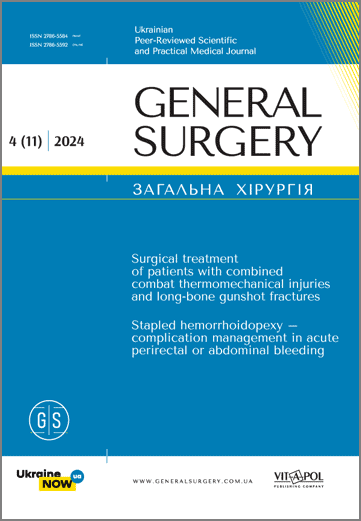Peculiarities of a differentiated approach to surgical treatment of patients with combined combat thermomechanical injuries and long-bone gunshot fractures by the levels of patient care
DOI:
https://doi.org/10.30978/GS-2024-4-8Keywords:
combined combat thermomechanical injury, gunshot wound, polytrauma, syndrome of mutual aggravation of injuries, traumatic shock, burnsAbstract
Objective — to improve treatment outcomes for wounded individuals with long‑bone fractures and combined combat thermomechanical injuries (CCTMI) by developing and implementing a differentiated approach to surgical treatment at different levels of patient care.
Materials and methods. The surgical outcomes of 178 wounded individuals with long‑bone fractures and CCTMI were investigated. The study employed general clinical, surgical, laboratory, biochemical, morphological, and statistical methods. The wounded individuals were divided into two clinical comparison groups: the main group and the control group. The main group included 91 wounded individuals with long‑bone gunshot fractures who underwent surgical treatment according to a differentiated surgical approach that involved assessing the severity of CCTMI. The control group included 87 wounded individuals with long‑bone gunshot fractures and CCTMI who received standard surgical treatment for burn and gunshot wounds. The comparative analysis was carried out based on age, the specific gravity of long‑bone gunshot fractures, body surface area of the burn, type of wound tract, number of wounds, type of injury, time of admission, the effectiveness of organizational and medical interventions (p >0.05).
Results. The analysis of treatment interventions revealed that the incidence of fasciotomies in the main group was 27.47% compared to only 9.20% in the control group. Additionally, the application of vacuum therapy reached 40.91% versus 23.17% in the control group (p <0.05). In CCTMI with significant bone defects, the main group used more modern fragment‑fixing procedures, including the Ilizarov apparatus and the two‑stage Masquelet technique (84.09% vs. 50.00%, p <0.01). The use of the admission trauma scale (AdTS‑CCTMI) and the perfusion index in all cases of the main group facilitated the timely assessment of the patient’s condition, improving treatment quality and preventing complications. In terms of early complications, the main group had considerably lower rates of anemia (62.64% vs. 78.16%, p <0.05), resulting in fewer metabolic changes in the myocardium (23.08% vs. 36.78%) and acute renal failure (9.89% vs. 14.94%). The control group experienced nearly twice as many thromboembolic problems (12.64% vs. 7.69%, p <0.05), highlighting the need for improved preventive measures. Among the late complications, postoperative wound suppuration and osteomyelitis remained significant challenges. However, these complications were less common in patients in the main group (9.89% and 6.59%, respectively) than in the control group (21.84% and 16.09%). 4.40% of patients in the main group underwent limb re‑amputations for gangrene or osteomyelitis compared to 10.34% in the control group (p <0.05).
Conclusions. The functional treatment outcomes, as measured by the Mattis‑Lyuboshyts‑Schwarzberg scale, demonstrated an increase in the proportion of good results from 39.08±5.23% to 56.98±2.85%, with a decrease in the relative number of unsatisfactory results from 18.39±4.15% to 6.24±0.31%, at p <0.05. A differentiated surgical strategy with an objective assessment of injury severity at different levels of patient care resulted in a decrease in mortality from 10.34% in the control group to 5.49% in the main group, reflecting a reduction of 4.85%.
References
Braun J, Gertz SD, Furer A, et al. The promising future of drones in prehospital medical care and its application to battlefield medicine. J Trauma Acute Care Surg. 2019;87(1S Suppl 1):S28-S34. https://doi.org/10.1097/TA.0000000000002221.
Edwards MJ, Lustik M, Eichelberger MR, et al. Blast injury in children: an analysis from Afghanistan and Iraq, 2002-2010. J Trauma Acute Care Surg. 2012;73(5):1278-83. https://doi.org/10.1097/TA.0b013e318270d3ee.
Kobayashi K. Damage control surgery – a historical view. Nippon Geka Gakkai Zasshi. 2002;103(7):500-2.
Kuchyn IL, Horoshko VR. Predictors of treatment failure among patients with gunshot wounds and post-traumatic stress disorder. BMC Anesthesiol. 2021;21(1):263. https://doi.org/10.1186/s12871-021-01482-8.
Lindholm C, Searle R. Wound management for the 21st century: combining effectiveness and efficiency. Int Wound J. 2016;13(Suppl 2):5-15.
Liu D, Huang SY, Sun JH, et al. Sepsis-induced immunosuppression: mechanisms, diagnosis and current treatment options. Mil Med Res. 2022;9(1):56. https://doi.org/10.1186/s40779-022-00422-y.
Martin R, Taylor S, Palmieri TL. Mortality following combined burn and traumatic brain injuries: An analysis of the national trauma data bank of the American College of Surgeons. Burns. 2020;46(6):1289296. https://doi.org/10.1016/j.burns.2020.06.022.
Obst W, Esser T, Kaasch AJ, et al. The need of antimicrobial stewardship in post-operative infectious complications of abdominal surgery. Visc Med. 2022;38(5):345-53. https://doi.org/10.1159/000526785.
Sandhu A, Claireaux HA, Downes G, Grundy N, Naumann DN. Emergency first responder management of combat injuries to the torso in the military, remote and austere settings. BMJ Mil Health. 2022;168(6):478-82. https://doi.org/10.1136/bmjmilitary-2020-001460.
Skube ME, Mallery Q, Lusczek E, Elterman J, Spott MA, Beilman GJ. Characteristics of combat-associated small bowel injuries. Mil Med. 2018;183(9-10):e454-e459. https://doi.org/10.1093/milmed/usy009.
Sugrue M, D’Amours SK, Joshipura M. Damage control surgery and the abdomen. Injury. 2004;35(7):642-48. https://doi.org/10.1016/j.injury.2004.03.011.
Treadwell JR, Lucas S, Tsou AY. Surgical checklists: a systematic review of impacts and implementation. BMJ Qual Saf. 2014;23(4):299-318. https://doi.org/10.1136/bmjqs-2012-001797.
Walsh TJ, Hospenthal DR, Petraitis V, Kontoyiannis DP. Necrotizing mucormycosis of wounds following combat injuries, natural disasters, burns, and other trauma. J Fungi (Basel). 2019;5(3):57. https://doi.org/10.3390/jof5030057.
Widgerow AD, King K, Tocco-Tussardi I, et al. The burn wound exudate-an under-utilized resource. Burns. 2015 Feb;41(1):11-7. https://doi.org/10.1016/j.burns.2014.06.002.
Yongqiang Z, Dousheng H, Yanning L, Xin M, Kunping W. Peacekeepers suffered combat-related injuries in Mali: a retrospective, descriptive study. BMJ Mil Health. 2020;166(3):161-6. https://doi.org/10.1136/jramc-2018-001010.
Downloads
Published
How to Cite
Issue
Section
License
Copyright (c) 2025 Authors

This work is licensed under a Creative Commons Attribution-NoDerivatives 4.0 International License.






